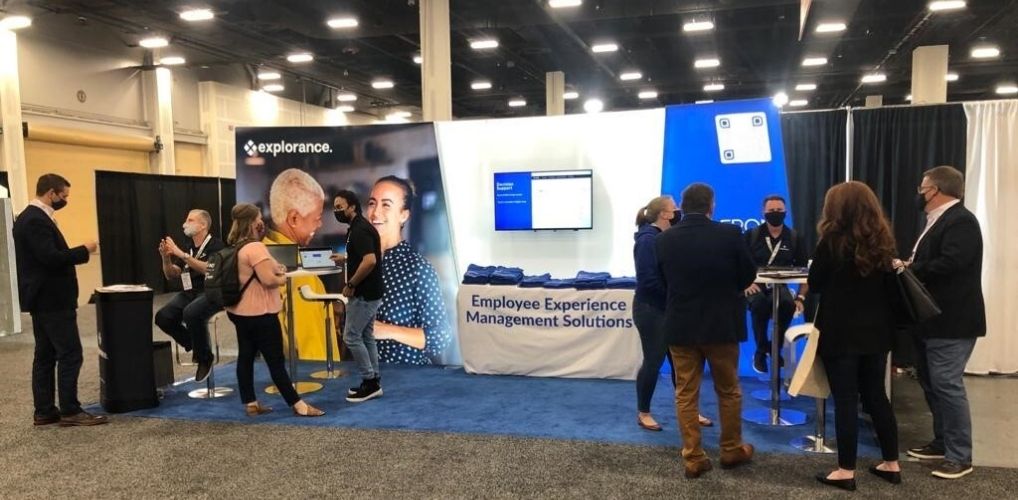HR Tech Conference Report: Why the Employee Experience Now Ranks as a Top Corporate Priority

Reading Time: Less than 4 mins.
Synopsis: The annual HR Tech Conference, which took place in September, connects HR and talent professionals to the latest technology. Explorance was onsite to deliver a Tech Talk on the transformative power of comment analysis, and help attendees get to grips with their most pressing HR challenges. In this blog post, Explorance’s Senior Consultant Steve Lange gives his thoughts on an important undercurrent he noticed at this year’s conference.
Taking place last month in Las Vegas, HR Tech is a landmark conference focused on technology in the HR industry. However, in addition to the focus on technology, the need to deliver a better, more human-centric Employee Experience was a hot topic.
This is with good reason.
It’s why Explorance was proud to present BlueML at HR Tech, connecting enterprises with this unique Machine Learning-enabled comment analysis solution. With BlueML, the comments employees make about their experiences are rapidly analyzed, enabling businesses to take prompt action based on the sentiment they discover.
Noticeably, recent data shared by Josh Bersin has noted that 42% of HR technology projects are either only partially successful or fail after two years. The number one reason? A poor Employee Experience.
As a result, managing the Employee Experience has gone from a “nice to have” to a top corporate priority.
While HR Tech was still a technology-focused conference, almost every single session emphasized that people are what makes everything work.
Measuring HR’s Value
In this spirit, ADP Research and Marcus Buckingham used the conference to unveil the new HR Experience Score (HRXPS). The HRXPS has been statistically proven to show that when employees rate HR as driving value, a company’s talent brand is also promoted. In fact, it’s 8 times more likely to be recommended by that employee, to be precise.
The message is clear: HR can drive value for a company and the need is critical right now, as ‘The Great Resignation’ continues to unfold and drive turnover in almost every industry.
A very valid criticism that could be directed towards HR Technology over the last 30 years is that traditionally, HR tools have been built for HR as an organization, not the employees whom HR is supposed to enable.
This is where the connection to the Employee Experience comes in. The workplace experience should arguably be designed from the human/employee perspective. The work, skills, jobs, processes, and strategy – everything that makes up the experience.
The Evolution of Enablement
So where does this leave us today? There’s an argument to be made to re-brand Human Resources to Human Enablement, or Employee Enablement. With the focus on the employee/human experience it seems appropriate. No matter how you look at it, HR and the associated technology is right now being reinvented, with the focus at HR Tech’s sessions including:
- Working better for humans
- Focusing on skills
- Creating an engaged environment where employees feel safe, understood, and valued
- Growing the trust within an organization.
It is important to note that realizing the above is not just the job of HR. The Employee Experience needs to be employee-centric AND cross functional. When it comes to designing, building, and organizing the new digital employee experience, each group or function needs to own their “moments that matter” along the employee journey map and work together to develop a seamless, consumer-grade user experience.
Certainly, technology plays a role in execution, however putting in place the proper mindset, people, and fully thought-out journeys are just as important.
A People-Oriented Mindset
Attending HR Tech 2021 makes it very clear that technology remains a crucial enabler for enterprise level businesses.
However, while having a digital mindset is critical, companies still need human-oriented strategies and interactions to drive the value of the HR organization. Being ‘Digital’ means having a strategy for what technology can do/shouldn’t do and where human interactions are wanted and needed.
A major aspect of this new organizational purpose is committing to continuously listen to employees.
That doesn’t mean twice-in-a-year engagement surveys, purely post-learning feedback, or the usual annual performance reviews.
We need to be listening in the white spaces along the employee journey and paying attention to the highway of an employee’s path through the organization. This means listening, gathering data, and gleaning insights. Most of all, it means taking action and letting people know they have been heard.
Employees who experience this will not only thank the organization, they will feel more valued, engaged with the business, and will give back more to the organization.
[“source=qvault”]

